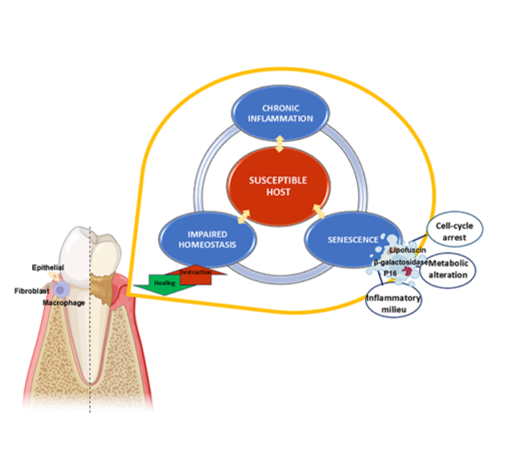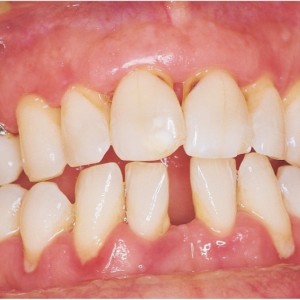
New Drug Therapy with Natural Compound Shows Promise Against Periodontal Diseases
Periodontal diseases, commonly known as gingivitis and periodontitis, remain a significant global health challenge, affecting nearly 60% of adults aged 65 and older and contributing to substantial medical, psychological, and financial burdens. Driven by a deregulated immune response to oral bacteria, chronic inflammation can not only lead to gum tissue destruction and tooth loss but also is linked to numerous systemic conditions.
Researchers at Penn Dental Medicine discovered in a previous clinical study that the chronic gum inflammation can promote an aging-related condition called “senescence,” even in younger tissues. Senescent cells, which have permanently ceased to divide in response to stress, secrete inflammatory molecules that increase tissue damage, impair healing, and accelerate disease severity.
Now, a new translational study by the same research team reveals that targeting senescent cell burden could be an effective strategy for managing periodontal disease and promoting oral health.
In a paper recently published in the Journal of Dental Research (April 2025), the researchers showed that an anti-senescence therapy or “senotherapy,” consisting of an enzyme inhibitor called dasatinib and a natural flavonoid plant compound called quercetin, reduced markers of senescence and associated periodontal inflammation and bone loss in lab-dish and animal models.
“Our findings suggest that senotherapy offers a promising approach to preserving periodontal health,” says Dr. Esra Sahingur of Penn Dental Medicine. “Periodontitis is more than a bacterial infection—it’s driven by immune and metabolic dysfunction, cellular aging, and inflammation. By targeting inflammation and senescent cells, we may disrupt chronic disease cycle and unlock new preventive and therapeutic possibilities for oral and systemic health.”
Cells exposed to stressors like inflammation, oxidative stress, and microbial toxins can enter a senescent state, ceasing to divide and losing normal function. These cells also release molecules that fuel further inflammation and senescence in surrounding tissues. Senotherapies, which target senescent cells by eliminating them or suppressing their harmful effects, are gaining attention for a host of potential clinical applications, and now periodontal diseases as well.
In their new study, Sahingur and her team used the dasatinib-quercetin (DQ) combination, a senotherapy that has shown an ability to reduce senescent cell numbers and senescence markers in other clinical contexts.
In lab-dish experiments, the team exposed gum cells called keratinocytes to periodontitis-associated bacteria, which induced a senescence-like molecular signature. Treatment with DQ significantly weakened this signature—as did quercetin alone comparably.
The results extended to a live animal model as well. In aging mice, which exhibit features of senescence as they age, DQ treatment significantly decreased senescence markers and senescence-associated inflammatory mediators in gum tissues, restoring them to levels observed in young, non-senescent gums. Importantly, the DQ supplements also prevented much of the loss of alveolar bone—the bone in which teeth are rooted—suggesting that senotherapy could help preserve the structural integrity of the periodontium.
“These results are consistent with our previous studies and a growing body of research that shows the powerful role of natural compounds, like quercetin, in promoting oral and systemic health,” says Sahingur.
Sahingur and her team now hope to initiate an early-stage clinical trial to assess the effects of quercetin—a widely available and safe over-the-counter supplement—on biological and clinical markers in patients with gum diseases. She says that future clinical trials might also investigate the benefits of adding dasatinib, which is currently used in leukemia, at lower doses and intermittently to determine its safety and efficacy in periodontal applications.
“Our hope is that these initial clinical trials will provide proof-of-concept for leveraging the therapeutic potential of natural products- either as standalone agents or in combination regimens—as host modulatory strategies to enhance clinical outcomes in the management of periodontitis,” Sahingur says. “If successful, this could lay the foundation for more targeted and effective treatments and delivery options, particularly for patients at high risk of severe periodontal diseases, such as the elderly, diabetics, and immunocompromised.”
The study included multiple students from different programs, including undergraduate students at the Penn Center for Undergraduate Research and Fellowships, dental students from Penn Dental Medicine’s summer research program, and a graduate student from Penn Dental Medicine’s DScD program.
Sahingur is an associate professor in the Department of Periodontics and Associate Dean of Graduate Studies and Student Research at Penn Dental Medicine
Other authors are K. Rattanaprukskul, X.-J. Xia, M. Hysa, M. Jiang, M. Hung, and S.F. Suslavich.
The research was supported in part by the National Institute of Dental and Craniofacial Research (R01DE025037 and R01DE027374).
Source: https://www.dental.upenn.edu/
 Related articles
Related articles
News 09 September 2025
Chemomouthpiece, LLC, a privately held medical device company that develops and commercializes supportive cancer care products, today announced that the peer-reviewed results from its pivotal,...
Products 19 June 2025
SMART Design Shows Feasibility for Clinical Trials When Treating Challenging Periodontal Cases
Researchers from the Faculty of Dentistry, Oral & Craniofacial Sciences at King’s College London have conducted the first randomised controlled trial for the treatment of Grade III...
News 03 June 2025
A new report from CareQuest Institute for Oral Health reveals that 27% of U.S. adults—an estimated 72 million people—do not have dental insurance, nearly three times the number of adults who lack...
Editorials 17 January 2025
Penn Dental Medicine Study Shows Saliva Test May Help Mark Gum Disease Progression
easuring levels of key proteins in patients’ saliva may be a relatively easy way for dentists—and even patients themselves—to track the progression of gum disease (periodontitis), suggests a...
 Read more
Read more
Editorials 10 October 2025
With proud smiles and crisp white coats, ninety-three learners from the DDS Class of 2029 and the International Dentist Pathway Class of 2028 marked the start of their dental careers at the UCSF...
Periodontology 10 October 2025
Continuous professional development (CPD) in Periodontology refers to the overall framework of opportunities that facilitate a life-long learning practice, driven by the learner-practitioner and...
TheraBreath, the #1 alcohol-free mouthwash brand in the U.S.*, has introduced a new line of dentist-formulated, clinically tested toothpastes designed to support professional oral care...
News 10 October 2025
New officers and trustees were installed at the Minnesota Dental Association’s Leadership Conference on September 19 in Minneapolis.
News 10 October 2025
Smartee Denti-Technology today announced that Professor Gang Shen, its Chief Scientist and Executive President of TaiKang ByBo Dental, has once again been named to the World’s Top 2% Scientists...















